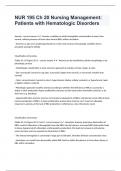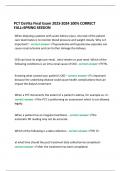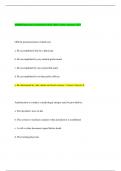NUR 195 Ch 20 Nursing Management:
Patients with Hematologic Disorders
Anemia - correct answer ✔✔- Anemia: condition in which hemoglobin concentration is lower than
normal, reflects presence of fewer than normal RBCs within circulation
- Anemia is a sign of an underlying disorder & is the most common hematologic condition that is
prevalent among the elderly
Classification of Anemias
(Table 20-1 & Figure 20-1) - correct answer ✔✔- Anemia can be classified by cellular morphology or by
physiologic process
- Morphologic classification is most common approach & includes cell size, shape, & color
- Size: normocytic (normal or avg size), macrocytic (larger than normal), or microcytic (smaller than
normal)
- Color: normochromic (normal in color), hyperchromic (darker cellular contents), or hypochromic (pale
or lighter cellular contents)
- Physiologic approach classifies anemia according to whether the deficiency in RBCs is caused by a
defect in their production (hyper proliferative anemia), by their destruction (hemolytic anemia), or by
their loss (e.g. bleeding)
- Hyperproliferative Anemia: marrow can't produce adequate #s of RBCs; reticulocyte count reflects bone
marrow production of RBCs--in hypo proliferative anemia bone marrow can't mount an adequate
response to anemia, & this lack of RBC production is reflected as a low reticulocyte count
-
Classification of Anemias
(Table 20-1 & Figure 20-1) Cont'd - correct answer ✔✔- Hemolytic Anemia: premature destruction of
RBCs results in liberation of hemoglobin from the RBCs into the plasma--increased RBC destruction leads
to tissue hypoxia (which stimulates erythropoietin production); this leads to increase in reticulocyte
count sas bone marrow responds to destruction of RBCs
- The release hemoglobin is converted in large part to bilirubin, therefore bilirubin concentration rises
- Hemolysis: can result from abnormality within RBC itself or within the plasma, or from direct injury to
RBC within circulation
,-To determine if the presence of anemia in a given pt is caused by destruction or by inadequate
production of RBCs, consider: 1) marrow's ability to respond to decreased RBCs (evidenced by increased
reticulocyte count) 2) degree to which young RBCs proliferate in bone marrow & the manner in which
they mature 3) presence or absence of end products of RBC destruction within circulation
Examples of Different Types of Anemias
(Table 20-2) - correct answer ✔✔- Hyperproliferative: pernicious (megaloblastic), folate deficiency, iro
deficiency, decreased erythropoietin production, anemia of chronic disease (AIDS, malignancy, ect),
aplastic anemia
- Blood Loss: bleeding
- Hemolysis: autoimmune hemolytic anemia (acquired/ caused by extrinsic insults like infection, meds,
venom, or trauma), thalassemias (inherited forms of autoimmune hemolytic anemia)
Clinical Manifestations & Assessment
(Box 20-1 are s/s of anemia) - correct answer ✔✔- Aside from severity of the anemia itself, several
factors influence development of anemia-associated symptoms: 1) rapidity w/ which anemia has
developed 2) duration of anemia 3) metabolic requirements of pt 4) other concurrent disorders (e.g.
cardiopulmonary disease)
- Usually, the more rapidly an anemia develops, the more severe its symptoms
- People who are very active or who have significant demands on their lives are more likely to experience
symptoms
- Hematologic studies are performed to determine type & cause of anemia: hemoglobin, heatocrit,
reticulocyte count, & RBC indices, iron studies, serum Vit B12 & folate lvls, & haptoglobin &
erythropoietin lvls
- CBC values are useful in determining whether anemia is an isolated problem or part of another
hematologic condition
- Bone marrow aspiration may be performed
Medical Management: Anemia - correct answer ✔✔- Management of anemia is directed toward
correcting or controlling the cause--if anemia is severe, RBCs may be replaced w/ transfusion of packed
RBCs
Nursing Management: Anemia (Managing Fatigue) - correct answer ✔✔- Fatigue is most common
symptom of anemia
,- Fatigue is often the symptom that has the greets negative impact on a pt's lvl of functioning &
consequent quality of life
- The severity of distress from fatigue is often related to a person's responsibilities & life demands, as
well as the amount of assistance & support received from others
- Nursing interventions can focus on assisting the pt to prioritize activities & to establish a balance b/w
activity & rest that is realistic & feasible from the pt's perspective
- Pts w/ chronic anemia need to maintain some physical activity & exercise to prevent the deconditioning
that results from inactivity; Short periods of daily exercise can also decrease the severity of fatigue
Nursing Management: Anemia (Maintaining Adequate Nutrition) - correct answer ✔✔- Inadequate
intake of essential nutrients (iron, Vit B12, & folic acid) can cause some anemias-- The symptoms
associated w/ anemia (e.g., fatigue, anorexia) can in turn interfere w/ maintaining adequate nutrition;
healthy diet should be encouraged
- The nurse should inform the pt that alcohol interferes w/ utilization of essential nutrients & should
advise pt to avoid/limit alcohol intake
- Dietary teaching sessions should be individualized & culture-sensitive to food preferences &
preparation
- The involvement of family members enhances compliance w/ dietary recommendations
- Dietary sups may be prescribed as well
- The pt & family must understand the underlying cause of the anemia b/c many forms of anemia are not
the result of a nutritional deficiency-- In such cases, even excessive intake of nutritional sups will not
improve the anemia
Nursing Management: Anemia (Maintaining Adequate Perfusion) - correct answer ✔✔- Pts w/ acute
blood loss or severe hemolysis may have decreased tissue perfusion from decreased blood volume or
reduced circulating RBCs (decreased hematocrit
- Lost volume is replaced w/ transfusions or IV fluids, based on symptoms & lab test results
- Nurse monitors pt's vitals & pulse oximeter readings closely, other meds like antihypertensive agents,
may need to be adjusted or withheld
Complications: Anemia - correct answer ✔✔- General complications of severe anemia include: heart
failure, paresthesias, & confusion
- At any lvl of anemia, pts w/ underlying heart disease are far more likely to have angina or symptoms of
heart failure that those w/o heart disease
, Hyperproliferative Anemias: Iron Deficiency Anemia - correct answer ✔✔- Occurs when body's iron
stores are depleted & there is no iron available for hemoglobin synthesis
- Volume of individual iron stores is dependent on sex, age, rate of growth, & the balance b/w dietary
iron absorption & losses
- Most common anemia in the world
- For most adults the cause of this anemia is blood loss, but other causes are iron malabsorption
Iron Deficiency Anemia: Medical Management - correct answer ✔✔- Except in cases of pregnancy, the
cause of iron deficiency anemia should be investigated
- Stool specimens should be tested for occult blood & people 50yrs + should have periodic colonoscopy
& endoscopy to detect ulcerations, gastritis, polyps, or cancer
- Several oral iron preps (ferrous sulfate, ferrous gluconate, & ferrous fumarate) are available for treating
iron deficiency anemia--important to take for as long as 6-12 months for iron stores to replenish (Vit C
facilitates iron absorption so iron sups should be taken w/ OJ or Vit C tablet to maximize absorption)
- Ig oral iron is poorly absorbed or not tolerated, or iron is needed in large amount, IV or IM admin of
iron dextran may be needed (small dose done first to avoid risk of anaphylaxis w/ IM or IV injections--
emergency meds, like epinephrine, should be close at hand & if no signs of allergic reaction occur in 30
mins, remaining dose of iron can be administered))
Iron Deficiency Anemia: Nursing Management
(Box 20-2) - correct answer ✔✔- Preventative education is important, b/c iron deficiency anemia is
common is menstruating & pregnant women
- Food high in iron include: organ meats (liver's), other red meats, beans, leafy green veggies, raisins, &
molasses
- Nurse helps pt select healthy diet; Pts w/ history of eating fad diets or strict vegetarian diets are
counseled that such diets often contain inadequate amounts of absorbable iron
- Nurse encourages pt to continue iron therapy as long as it is prescribed, even if the symptoms of
anemia resolve; Pt is instructed to take iron sup 1 hr before meals b/c it is absorbed best on empty
stomach (Tabs w/ enteric coating may be poorly absorbed & should be avoided)
- Many pts have difficulty tolerating iron sups b/c of GI side effects (e.g. constipation)
- IM injection of iron causes local pain & can stain skin--these side effects are minimized by using Z-track
technique from administering iron dextran deep into gluteus maximus muscle (buttock); nurse avoids
vigorously rubbing the injection site after injection to limit staining of skin; B/c of problems w/ IM admin,
IV rough is preferred for iron dextran admin






